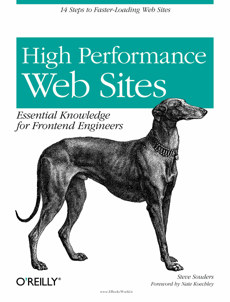High Performance Web Sites

آیا میخواهید که وب سایت شما سریعتر نمایش داده شود؟ در این کتاب 14 راهکار برای سریعتر کردن زمان پاسخ گویی بین 25 تا 50 درصد ارائه شده است. نویسنده این کتاب یعنی Steve Souders در شغل خود به عنوان سرپرست کارایی Yahoo این best practiceها را به هنگام بهینه سازی صفحات پر بازدید وب جمع آوری کرده است. حتی سایت هایی که هم اکنون کاملا بهینه شده اند به مانند جست و جوی یاهو یا صفحه اصلی یاهو، میتوانند به سادگی از این نکات برای افزایش کارایی خود بهره مند شند.
The rules in High Performance Web Sites explain how you can optimize the performance of the Ajax, CSS, JavaScript, Flash, and images that you've already built into your site -- adjustments that are critical for any rich web application. Other sources of information pay a lot of attention to tuning web servers, databases, and hardware, but the bulk of display time is taken up on the browser side and by the communication between server and browser.High Performance Web Sites covers every aspect of that process.
Each performance rule is supported by specific examples, and code snippets are available on the book's companion web site. The rules include how to:
• Make Fewer HTTP Requests
• Use a Content Delivery Network
• Add an Expires Header
• Gzip Components
• Put Stylesheets at the Top
• Put Scripts at the Bottom
• Avoid CSS Expressions
• Make JavaScript and CSS External
• Reduce DNS Lookups
• Minify JavaScript
• Avoid Redirects
• Remove Duplicates Scripts
• Configure ETags
• Make Ajax Cacheable
If you're building pages for high traffic destinations and want to optimize the experience of users visiting your site, this book is indispensable.
"If everyone would implement just 20% of Steve's guidelines, the Web would be a dramatically better place. Between this book and Steve's YSlow extension, there's really no excuse for having a sluggish web site anymore."
-Joe Hewitt, Developer of Firebug debugger and Mozilla's DOM Inspector
"Steve Souders has done a fantastic job of distilling a massive, semi-arcane art down to a set of concise, actionable, pragmatic engineering steps that will change the world of web performance."
-Eric Lawrence, Developer of the Fiddler Web Debugger, Microsoft Corporation
1. Chapter 1 The Importance of Frontend Performance
1. Tracking Web Page Performance
2. Where Does the Time Go?
3. The Performance Golden Rule
2. Chapter 2 HTTP Overview
1. Compression
2. Conditional GET Requests
3. Expires
4. Keep-Alive
5. There's More
3. Chapter 3 Rule 1: Make Fewer HTTP Requests
1. Image Maps
2. CSS Sprites
3. Inline Images
4. Combined Scripts and Stylesheets
5. Conclusion
4. Chapter 4 Rule 2: Use a Content Delivery Network
1. Content Delivery Networks
2. The Savings
5. Chapter 5 Rule 3: Add an Expires Header
1. Expires Header
2. Max-Age and mod_expires
3. Empty Cache vs. Primed Cache
4. More Than Just Images
5. Revving Filenames
6. Examples
6. Chapter 6 Rule 4: Gzip Components
1. How Compression Works
2. What to Compress
3. The Savings
4. Configuration
5. Proxy Caching
6. Edge Cases
7. Gzip in Action
7. Chapter 7 Rule 5: Put Stylesheets at the Top
1. Progressive Rendering
2. sleep.cgi
3. Blank White Screen
4. Flash of Unstyled Content
5. What's a Frontend Engineer to Do?
8. Chapter 8 Rule 6: Put Scripts at the Bottom
1. Problems with Scripts
2. Parallel Downloads
3. Scripts Block Downloads
4. Worst Case: Scripts at the Top
5. Best Case: Scripts at the Bottom
6. Putting It in Perspective
9. Chapter 9 Rule 7: Avoid CSS Expressions
1. Updating Expressions
2. Working Around the Problem
3. Conclusion
10. Chapter 10 Rule 8: Make JavaScript and CSS External
1. Inline vs. External
2. Typical Results in the Field
3. Home Pages
4. The Best of Both Worlds
11. Chapter 11 Rule 9: Reduce DNS Lookups
1. DNS Caching and TTLs
2. The Browser's Perspective
3. Reducing DNS Lookups
12. Chapter 12 Rule 10: Minify JavaScript
1. Minification
2. Obfuscation
3. The Savings
4. Examples
5. Icing on the Cake
13. Chapter 13 Rule 11: Avoid Redirects
1. Types of Redirects
2. How Redirects Hurt Performance
3. Alternatives to Redirects
14. Chapter 14 Rule 12: Remove Duplicate Scripts
1. Duplicate Scripts—They Happen
2. Duplicate Scripts Hurt Performance
3. Avoiding Duplicate Scripts
15. Chapter 15 Rule 13: Configure ETags
1. What's an ETag?
2. The Problem with ETags
3. ETags: Use 'Em or Lose 'Em
4. ETags in the Real World
16. Chapter 16 Rule 14: Make Ajax Cacheable
1. Web 2.0, DHTML, and Ajax
2. Asynchronous = Instantaneous?
3. Optimizing Ajax Requests
4. Caching Ajax in the Real World
17. Chapter 17 Deconstructing 10 Top Sites
1. Page Weight, Response Time, YSlow Grade
2. How the Tests Were Done
3. Amazon
4. AOL
5. CNN
6. eBay
7. Google
8. MSN
9. MySpace
10. Wikipedia
11. Yahoo!
12. YouTube
 می پسندم
می پسندم
 به درد نمی خوره
به درد نمی خوره
















